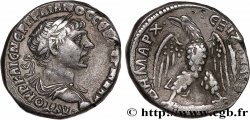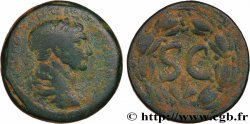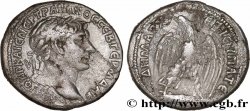brm_566100 - TRAIANO Aureus
non disponibile.
Articolo venduto sul nostro negozio (2020)
Prezzo : 4 500.00 €
Articolo venduto sul nostro negozio (2020)
Prezzo : 4 500.00 €
Tipo : Aureus
Data: 117
Nome della officina / città: Rome, Decennalia
Metallo : oro
Diametro : 20 mm
Asse di coniazione : 7 h.
Peso : 7,13 g.
Grado di rarità : R1
Commenti sullo stato di conservazione:
Bel exemplaire, bien centré, quasi TTB+. Très joli revers. Quelques faiblesses. Patine de collection
N° nelle opere di riferimento :
Diritto
Titolatura diritto : IMP TRAIANO AVG GER DAC P M TR P COS VI P P.
Descrittivo diritto : Buste lauré, drapé et cuirassé de Trajan à droite, vu de trois quarts en arrière (A*2).
Traduzione diritto : "Imperatori Traiano Augusto Germanico Dacico Pontifici Maximo Tribuniciæ Potestate Consule quintum Patri Patriæ", (À l'empereur Trajan auguste germanique dacique grand pontife revêtu de la puissance tribunitienne consul pour la cinquième fois père de la patrie).
Rovescio
Titolatura rovescio : S P Q R OPTIM-O PRINCIPI.
Descrittivo rovescio : Aigle légionnaire au centre entre deux enseignes surmontées d’une couronne à gauche, d’une main coupée à droite.
Traduzione rovescio : “Senatus Populus Que Romanus Optimo Principi”, (au nom du Sénat et du Peuple romain au meilleur des princes).
Commento
Rubans de type 3. Ptéryges à peine visibles sous le paludamentum. Il revient à l’école anglaise et aux travaux de P. V. Hill, The dating and arrangement of the Undated Coins of Rome AD. 98-148, Londres 1970, d’avoir reclassé les différentes émissions de l’atelier de Rome, grâce à la théorie des cycles et d’avoir mis en lumière l’organisation de l’atelier de Rome qui travaille en officines et non pas en fonction du métal comme l’avaient décrit les numismates du XIXe siècle.
Type 3 ribbons. Pteryges barely visible under the paludamentum. It is the English school and the work of PV Hill, The dating and arrangement of the Undated Coins of Rome AD. 98-148, London 1970, which reclassified the various issues of the Rome mint, thanks to the theory of cycles and to have highlighted the organization of the Rome mint which worked in officinas and not according to the metal as the 19th century numismatists had described it.
Type 3 ribbons. Pteryges barely visible under the paludamentum. It is the English school and the work of PV Hill, The dating and arrangement of the Undated Coins of Rome AD. 98-148, London 1970, which reclassified the various issues of the Rome mint, thanks to the theory of cycles and to have highlighted the organization of the Rome mint which worked in officinas and not according to the metal as the 19th century numismatists had described it.








 Segnalare un errore
Segnalare un errore Stampate la pagina
Stampate la pagina Condividi mia selezione
Condividi mia selezione Fai una domanda
Fai una domanda Consegnare / vendere
Consegnare / vendere
 Descrittivo
Descrittivo















